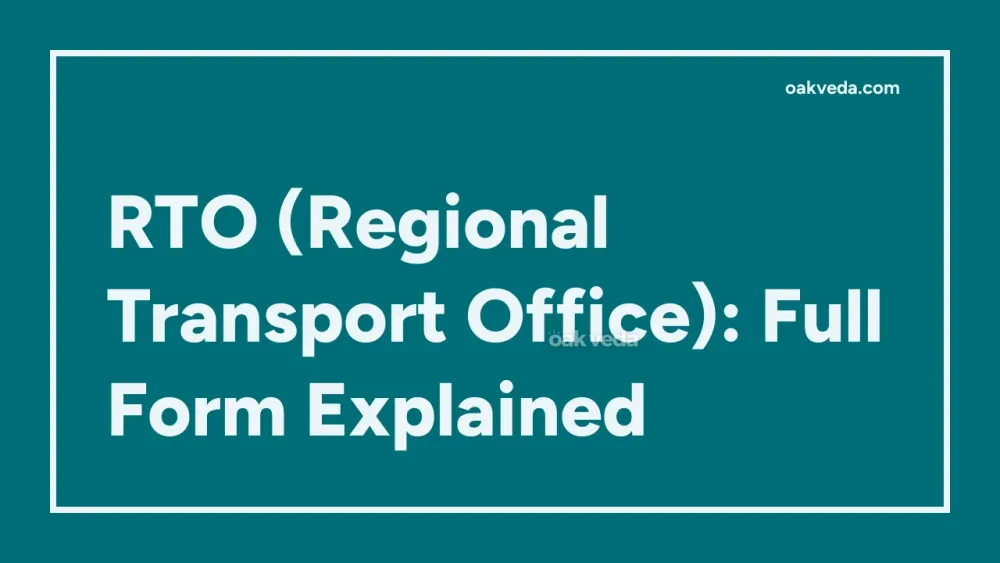
What is the Full Form of RTO?
The full form of RTO is Regional Transport Office, also known as Road Transport Office in some contexts. This government organization plays a crucial role in managing and regulating road transport in India.
What is Regional Transport Office?
The Regional Transport Office (RTO) is a government body in India responsible for maintaining a comprehensive database of vehicles and drivers across various states. It serves as the primary authority for issuing driving licenses, vehicle registration documents, and enforcing road transport regulations.
Origin and Development of Regional Transport Office
The concept of the RTO in India can be traced back to the Motor Vehicles Act of 1988, which laid the foundation for a centralized system of vehicle and driver management. Over the years, RTOs have evolved from paper-based offices to digitized centers, adapting to technological advancements and the growing needs of India's burgeoning automotive sector.
How does the Regional Transport Office work?
RTOs operate at the state level, with each state having its own network of offices. These offices work in coordination with the central government to implement national policies while addressing local transportation needs. The RTO system has undergone significant modernization, with many services now available online, reducing paperwork and improving efficiency.
Functions of Regional Transport Office
The RTO performs several critical functions in the automotive ecosystem:
- Vehicle Registration: Issuing and maintaining records of all registered vehicles in the state.
- Driving Licenses: Processing and issuing driving licenses to qualified individuals.
- Fitness Certification: Conducting routine inspections and issuing fitness certificates for vehicles.
- Tax Collection: Collecting road tax and other vehicle-related taxes.
- Permit Management: Issuing and managing permits for commercial vehicles like taxis and trucks.
- Emission Control: Checking emission levels and issuing pollution under control (PUC) certificates.
- Policy Implementation: Enforcing new rules and regulations related to road transport.
Applications of Regional Transport Office
The RTO's services are essential for various stakeholders in the transportation sector:
- Vehicle Owners: For registration, transfer of ownership, and obtaining necessary documents.
- Drivers: For obtaining and renewing driving licenses.
- Commercial Operators: For acquiring permits and licenses for operating taxis, buses, and trucks.
- Law Enforcement: For verifying vehicle and driver information during checks.
- Insurance Companies: For accessing vehicle details during policy issuance and claims processing.
Features of Regional Transport Office
Modern RTOs in India have several notable features:
- Digitized Records: Most RTOs now maintain digital databases, improving data accuracy and accessibility.
- Online Services: Many RTO services are available online, reducing the need for in-person visits.
- Smart Cards: Driving licenses and registration certificates are now issued as smart cards, similar in size to a PAN card.
- Centralized Database: The VAHAN and SARATHI systems provide a centralized database for vehicle registration and driving licenses respectively.
- Standardized Processes: RTOs across states follow standardized procedures, ensuring consistency in service delivery.
Benefits of Regional Transport Office
The RTO system offers numerous benefits to citizens and the government:
- Streamlined vehicle registration and licensing processes
- Improved road safety through proper driver licensing and vehicle fitness checks
- Enhanced tax collection efficiency
- Better enforcement of traffic rules and regulations
- Reduced vehicle-related crimes through proper documentation
- Facilitation of inter-state vehicle movement and transfers
Limitations or Challenges of Regional Transport Office
Despite its importance, the RTO system faces several challenges:
- Long Wait Times: Many RTOs still struggle with long queues and processing delays.
- Corruption: Some offices face allegations of corruption in issuing licenses and certificates.
- Technology Adoption: Uneven implementation of digital services across different states.
- Manpower Shortage: Many RTOs are understaffed, leading to service delays.
- Public Awareness: Lack of awareness about online services and proper documentation requirements.
Future Developments in Regional Transport Office Technology
The future of RTOs in India looks promising with several technological advancements on the horizon:
- Artificial Intelligence: AI-powered systems for faster processing of applications and documents.
- Blockchain Technology: For secure and transparent record-keeping of vehicle and driver data.
- Mobile Apps: Comprehensive mobile applications for easy access to RTO services.
- Automated Testing: Advanced automated systems for driving tests and vehicle fitness checks.
- Integration with Traffic Management: Real-time integration with traffic management systems for better road safety and regulation.
FAQs on RTO Full Form
-
What is the difference between RTO and RTA? RTO (Regional Transport Office) and RTA (Regional Transport Authority) are often used interchangeably. However, RTA typically refers to the governing body, while RTO is the office that implements the policies.
-
How can I find my nearest RTO office? You can find your nearest RTO office by visiting the official website of your state's transport department or using the Ministry of Road Transport and Highways' online portal.
-
Are RTO services available online? Yes, many RTO services are now available online, including license renewals, vehicle registration, and tax payments. However, the availability of online services may vary by state.
-
What is the RTO state code? Each state in India has a unique RTO code. For example, MH for Maharashtra, DL for Delhi, KA for Karnataka, etc. These codes are used as prefixes in vehicle registration numbers.
-
How often do I need to renew my vehicle registration at the RTO? Private vehicles typically need to be re-registered every 15 years, while commercial vehicles may require more frequent renewals. The exact duration can vary based on vehicle type and state regulations.
By understanding the full form and functions of the RTO, citizens can better navigate the various processes related to vehicle ownership and operation in India. As the system continues to evolve, it promises to play an even more crucial role in ensuring road safety and efficient transportation management across the country.
You may be interested in:

